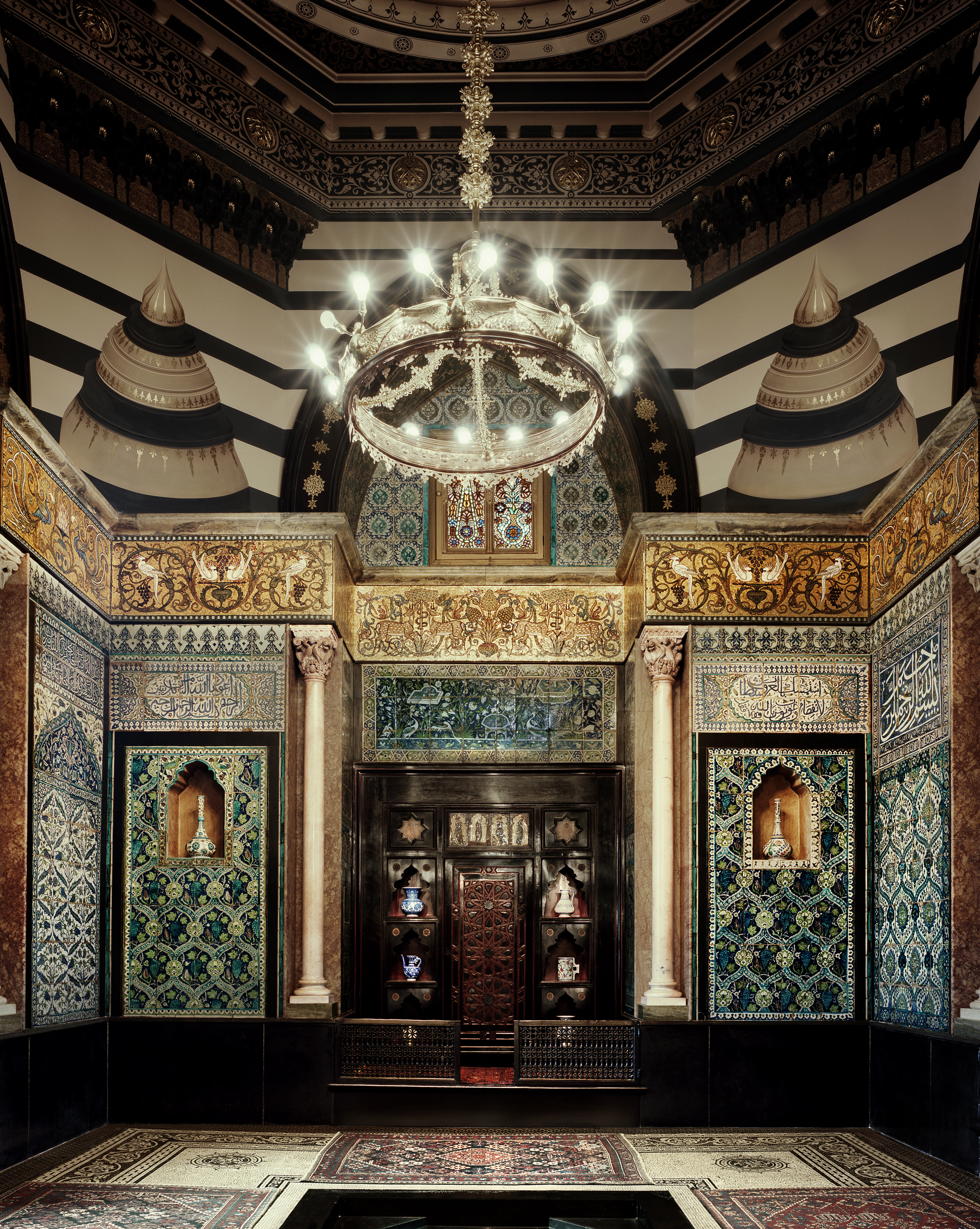Leighton House, Kensington, England – an artist’s studio and home…….

On a leafy street in Kensington, close to Holland Park, there is a 19th century house that is a true Victorian folly. I’m talking about Leighton House, home to the artist and sculptor Frederic, Lord Leighton. A bizarre mixture of Arabic architecture, Egyptian woodwork and Turkish hand-decorated ceramic tiles. The house is a monument to the man and to the artist. A Victorian gentleman’s home and studio.
Climbing the steps of the red brick building from the street I notice the domed turret at the western end of the property – mosque-like in appearance. Inside the house this dome creates a lofty ceiling in the Arabian or Narcissus Hall. A shallow reflecting pool is surrounded by elaborate, hand-painted tiles, carved wooden panels and engraved ceramics bearing quotations from the Koran. Daylight trickles in through the intricate trellis work that covers the windows. This is an entrance hall designed to impress and amaze the visitor. It suggests an owner who is well-travelled, erudite and bold.


In fact Frederic Leighton was one of the most well-known painters of his day. His Studio was designed to welcome visitors and to impress potential patrons. Over the years Queen Victoria, Robert Browning, John Millais, Lawrence Alma-Tadema and William Morris all visited. The Queen herself was an early customer! Leighton became President of the Royal Academy in 1878. A position he held until his death in 1896 – a period of almost two decades. This was the pinnacle of his career. He was passionate about art and very importantly he was independently wealthy – so he was able to live in an elegant style befitting his status as a successful artist. When you step into Leighton House it is the chance to step into the world of this wealthy, successful, Victorian artist.
Leighton first experienced public success in the summer of 1855. He exhibited a monumental painting at the Royal Academy which Queen Victoria purchased for £600. According to an extract from her journal she commented,
‘There was a very big picture, by a young man, called Leighton, his 1st attempt, at the age of 20…It is a beautiful painting quite reminding one of a Paul Veronese, so bright & full of lights. Albert was enchanted with it – so much so that he made me buy it. The young man’s father, said that his future career in life would depend on the success of this picture’.
In this painting Leighton was demonstrating his knowledge and appreciation of Italian Renaissance art. The picture shows a procession of ‘Cimabue’s Madonna’ through the streets of Florence. Cimabue (in white, centre) was the teacher of Giotto (also pictured in the centre in black stockings). On the far right of the canvas, in a soft cap with a pointed tail is the figure of Dante, whilst the man on the white horse with the white ermine stole is probably Lorenzo di Medici. Structurally the picture is fabulous, in terms of context and detail it is a visual treasure trove of references and information.

Cimabue’s Madonna by Frederic Leighton – exhibited Royal Academy, 1855
Leighton was a contemporary of the Pre-Raphaelites. He knew most of these painters, they were his friends and he was influenced by their work. The PRB as they were known wanted to take art back to the days before Raphael (pre-Raphaelite). They focused on classical art, beauty and nature. They also favoured a type of fairy-tale realism which fascinated the viewer. They also loved medieval myths, Arthurian legends and Biblical tales. I’m thinking here particularly of Holman Hunt’s incredible painting ‘The Scapegoat’. A graphically honest and disturbing painting of a goat cast into the desert loaded up with the pains, sins and evil deeds of the villagers. By casting the goat out into the desert the villagers believed they could metaphorically shed and abandon the nasty and unpleasant elements of their lives; lies, deceits, debts and personal vendettas. The picture is shown below. The poor creature stumbles hopelessly in a wilderness of salt flats, where there is no shelter, a relentless sun beating down and a complete absence of water. Note the bones and carcasses scattered, rather brutally, around the goat. A signifier of what will soon befall the goat. You can see this painfully realistic painting at the Lady Lever Art Gallery, Port Sunlight.
The Pre-Raphaelite artists were hugely popular in Britain. There were many, newly wealthy industrialists, factory owners and business men anxious to build up private art collections. Lord Lever, owner of Lever Brothers, a major producer and importer of palm oil from West Africa was one of them. Leighton was commissioned to paint an epic painting of a procession in classical Greece that was purchased by Lord Lever. In fact Lever started his art collection in the 1880s and collected many works from artists of the day – Leighton was always a firm favourite.

The ‘Daphnephoria’ is a painting showing a procession in Ancient Greece, it depicts a celebration to the god Apollo. At a recent exhibition at the Royal Academy in London some of the clay and wax models made by Leighton to help him correctly sketch and paint the principle figures in the painting are on display, Today this painting hangs in the Lady Lever Art Gallery, Port Sunlight. If you’d like to see this epic painting in real life head up to the Wirral Peninsula just south of Liverpool. The Lady Lever Art Gallery has a wonderful collection of Pre-Raphaelite paintings.
When I first visited Leighton House there was a temporary exhibition entitled ‘A Victorian Obsession’ which featured the romantic and classical paintings of Lawrence Alma-Tadema (a great friend and contemporary of Leighton). The highlight of the exhibition was Tadema’s ‘Roses of Heliogabalus’ painted in 1888. This spectacular canvas depicts a decadent feast held by the Roman Emperor – he has invited his guests to an orgy of sensory pleasures where the guests drown in pink rose petals. The painting was magnificently displayed in a room scented for the occasion with an elegant and evocative Jo Malone rose-perfume. The result was an assault on the senses of this vibrant, sensual, evocative painting. The profusion of colours and the mingling of the rose scent coming from each corner of the room was divine.

FLAMING JUNE – Now in 2024 the Royal Academy is proudly exhibiting one of Leighton’s most well known paintings, a canvas entitled ‘Flaming June’. This golden painting of a young woman, asleep on some far off sun-drenched shore is compelling and captivating. The young woman is powerful and muscular, exotically dressed in a flowing orange gown. The material is diaphanous, clinging to the contours of the subject. There’s a suggestion of ‘Sleeping Beauty’ dreaming peacefully, perhaps floating between the real and the imagined. There’s also a hint of danger in the frame. In the right hand corner oleander blooms droop over the marble balustrade, these flowers are poisonous and suggest a threat to the reposing beauty. This painting is on display in London for the rest of the year.

Flaming June – Frederic Leighton, 1895
POIGNANTLY the Flaming June canvas was completed the year before Leighton’s death. A fitting end to a prolific artist and sculptor whose work has influenced many artists since. An exhibition currently on show at The Royal Academy includes the ‘Flaming June’ painting. There are also various sculptures and models, in wax and plaster, created by Leighton and then developed into full-size sculptures or used to assist in the accurate depiction of subjects in larger canvases. I was particularly struck on a recent visit to the Fortuny Palazzo in Venice to see a painting by Mariano Fortuny that resonated strongly with me as (perhaps) taking its inspiration from ‘Flaming June’ (see below). Was Fortuny influenced by Lord Leighton?


Flaming June – Leighton, 1895 (left) and Mariano Fortuny’s Warrior Woman c. 1910 (right)
Frederic Leighton was an important artist, sculptor and president of The Royal Academy for almost two decades. This was at a time when Victorian England was discovering and consuming art and sculpture with great enthusiasm. Leighton’s house in Holland Park gives the visitor an insight into the life of a prolific artist in the 19th century, his studio is a joy and an inspiration. If you then combine the domestic life and home environment of Leighton with his public life at The Royal Academy it gives us, as viewers and observers, an insight into the life and work of a Victorian artist whose talent and precision was matched by his prolific output both on canvas and in sculpture.


Boy wrestling Python by Leighton (Tate Britain) – left. Right – Plaster model of ‘Laocoon’ (original in Vatican Museums, Rome)
Notes:
- Frederic Leighton was ennobled just before his death in 1896. He was born in 1830 and died in 1896.
- The photos of Leighton House, London are copyright Will Pryce
- Other photos are my own or in the public domain.
- The Roses of Heliogabalus is now part of the ‘Simon Perez Collection’ (Mexico).
- The photo is c. Studio Sebert Photographers.
- The Telegraph agrees with me on the subject of the ‘exceptional nature’ of the rooms at Leighton House, Leighton House and its opulent, oriental interiors
- A short video showing Leighton House. Leighton House on ‘you tube’
- Leighton House and 18 Stafford Terrace are managed by the RBKC – I strongly recommend a visit to both. RBKC Museums
- For more on Frederic, Lord Leighton and his fascinating life – here’s the wikipedia entry:
- https://en.wikipedia.org/wiki/Frederic_Leighton
- You may also like The Soane Museum – former home of Sir John Soane, the prolific and charismatic 19th century architect. This is probably my favourite small museum in London – My favourite London museum / The Soane’s own web site is: www.soane.org
- Giotto, student of Cimabue, went on to paint frescoes in Assisi and Padova which are unique and truly exceptional in terms of colour, perspective and quality. My article on Giotto and the Scrovegni Chapel frescoes: Padova, Italy – How does a money lender get into the kingdom of heaven….
- A trip to The Lady Lever Art Gallery, Port Sunlight is well worth the visit. Fantastic collection of Pre-Raphaelite paintings to be enjoyed: https://www.liverpoolmuseums.org.uk/lady-lever-art-gallery
- For more on the Pre-Raphaelites, Leighton and Victorian England head to Leighton House, Kensington or the Victoria & Albert Museum in Kensington.


- Written: 2014 / Updated: June 2016 / May 2019 / July 2021
- Re-written: March 2024


2 thoughts on “Leighton House, Kensington, London”